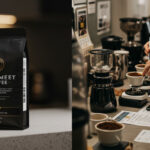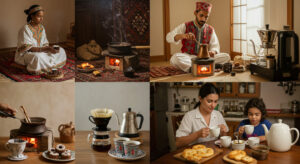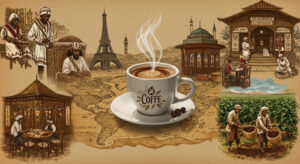
The Timeless Charm of Traditional Coffee: A Journey Through History and Flavor

Table of Contents
ToggleThe Origins of Traditional Coffee
The Ancient Roots of Coffee in Ethiopia and Yemen
The story of traditional coffee begins in the lush highlands of Ethiopia, where legend has it that a goat herder named Kaldi discovered the energizing effects of coffee beans after noticing his goats frolicking with unusual vigor. This serendipitous moment marked the dawn of coffee’s journey. From Ethiopia, the practice of brewing coffee traveled across the Red Sea to Yemen, where it became an integral part of Sufi monastic rituals. By the 15th century, Yemen’s port city of Mocha had become a bustling hub for coffee trade, introducing the world to the aromatic allure of this beloved beverage.
How Coffee Spread Across the Globe, Becoming a Staple
From the Arabian Peninsula, coffee’s influence expanded like the aroma of a freshly brewed cup. By the 16th century, it had reached the bustling streets of Istanbul, where the first coffeehouses, or qahveh khaneh, emerged as social and intellectual hubs. The allure of coffee soon captivated Europe, with Venice becoming one of the first cities to embrace it. By the 17th century, coffeehouses had sprouted in London, Paris, and Vienna, becoming centers of conversation and community. Coffee’s journey continued across the Atlantic, where it became a cornerstone of American culture, from the early colonial taverns to the iconic diners of the 20th century.
The Evolution of Brewing Methods Over Centuries
Traditional coffee has undergone a fascinating evolution in brewing methods, each reflecting the culture and ingenuity of its time. From the early Ethiopian practice of steeping coffee cherries in water to the intricate Turkish ibrik, which introduced the world to finely ground coffee, the art of brewing has always been a testament to human creativity. The 19th century saw the invention of the French press and the percolator, revolutionizing home brewing. Meanwhile, in Italy, the development of the espresso machine in the early 20th century gave birth to a new era of coffee craftsmanship. These methods, rooted in tradition, continue to inspire coffee lovers today.
Why Traditional Coffee Stands the Test of Time
The Comforting Simplicity of a Classic Brew
There’s something undeniably soothing about a cup of traditional coffee. It’s not about elaborate latte art or exotic flavor infusions—it’s about the pure, unadulterated essence of coffee itself. Whether it’s a robust black brew or a creamy diner-style cup, traditional coffee offers a sense of familiarity and comfort that transcends trends. It’s the kind of drink that feels like a warm embrace, a steady companion in the quiet moments of the morning or the late hours of the night.
How Traditional Coffee Connects Us to Our Roots
Traditional coffee is more than just a beverage; it’s a bridge to our past. For many, it evokes memories of grandparents brewing a pot on a stovetop or the aroma of coffee wafting through a family kitchen. It’s a reminder of cultural traditions—whether it’s the Italian espresso ritual, the Southern habit of sipping coffee on the porch, or the Scandinavian fika. These practices, passed down through generations, ground us in our heritage and remind us of the simple joys that have stood the test of time.
The Ritual of Brewing and Savoring Each Cup
Brewing traditional coffee is an art in itself—a ritual that invites mindfulness and patience. From measuring the grounds to waiting for the first drip, each step is a moment to slow down and appreciate the process. And when the coffee is finally ready, it’s not just about drinking it; it’s about savoring it. The rich aroma, the deep flavor, the warmth that spreads with every sip—these are the small pleasures that make traditional coffee a daily indulgence worth cherishing.
The Role of Traditional Coffee in Daily Life
A Morning Ritual: Starting the Day with a Strong Brew
For many, the day doesn’t truly begin until that first sip of traditional coffee touches their lips. The aroma of freshly brewed coffee wafting through the kitchen is a universal signal that it’s time to rise and shine. Whether it’s a robust French press, a classic drip coffee maker, or a stovetop percolator, the ritual of preparing and savoring that first cup is a cherished moment of calm before the day’s chaos unfolds. It’s not just about the caffeine—it’s about the comfort and familiarity of a timeless tradition that grounds us.
Coffee Breaks: Moments of Pause and Reflection
In the hustle and bustle of modern life, the coffee break stands as a sacred pause—a moment to step back, breathe, and reflect. Whether it’s a quick espresso at a café or a steaming mug at your desk, these breaks offer a chance to reset and recharge. Traditional coffee, with its rich flavors and warmth, becomes a companion in these moments of solitude or connection. It’s a reminder to slow down, even if just for a few minutes, and appreciate the simple pleasures of life.
The Communal Aspect of Sharing Coffee with Others
Coffee has always been more than just a beverage—it’s a social glue that brings people together. From family gatherings to casual meetups with friends, sharing a pot of coffee fosters conversation, laughter, and connection. The act of pouring a cup for someone else is a gesture of hospitality and warmth, rooted in cultural traditions across the globe. Whether it’s a diner-style coffee shared over a slice of pie or a carefully brewed pot enjoyed on a lazy Sunday morning, these moments create memories and strengthen bonds.
Exploring Classic Brewing Methods
The Timeless Drip Coffee Maker: A Household Favorite
For many Americans, the day begins with the familiar gurgle of a drip coffee maker. This trusted kitchen companion has been a staple in homes for decades, offering a reliable and consistent brew. Its simplicity is part of its charm—just add water, coffee grounds, and press start. The result? A pot of coffee that feels like a warm hug, ready to fuel mornings, family gatherings, or quiet moments of reflection. Whether it’s the retro-style models reminiscent of 70s diners or the sleek modern versions, the drip coffee maker remains a symbol of home and comfort.
The Art of French Press Brewing
For those who savor the ritual of coffee-making, the French press is a delight. This method invites you to slow down and appreciate the process. Coarse coffee grounds meet hot water, steeping like a fine tea, before the plunger is pressed down to separate the brew from the grounds. The result is a rich, full-bodied cup that captures the essence of the coffee bean. It’s a method that feels both rustic and elegant, a nod to European coffee traditions that have found a special place in American kitchens. As you sip, you’re reminded that sometimes, the best things in life require a little patience.
Pour-Over Coffee: Precision and Patience in Every Cup
Pour-over brewing is for the true coffee enthusiast, the one who finds joy in the details. This method involves pouring hot water in a slow, circular motion over coffee grounds in a filter, allowing the liquid to drip steadily into a cup or carafe. It’s a practice that demands focus and care, rewarding the brewer with a clean, nuanced flavor profile. The pour-over method has gained a cult following among coffee aficionados, but it’s also a beautiful way to connect with the craft of coffee-making. Every cup feels personal, a testament to the art of brewing and the joy of taking your time.
“Coffee is a ritual, a pause, a moment of clarity in a busy world.” – Unknown
Whether it’s the dependable drip, the indulgent French press, or the meticulous pour-over, these classic brewing methods remind us that coffee is more than just a drink—it’s a tradition, a craft, and a way to bring people together. Each method carries its own story, its own rhythm, and its own way of enriching our daily lives.
Traditional Coffee Around the World
Turkish Coffee: A Rich and Historic Tradition
Steeped in centuries of tradition, Turkish coffee is more than a beverage—it’s a ritual. Brewed in a special pot called a cezve, this finely ground coffee is simmered with water and sugar (if desired) until it forms a rich, velvety foam. Served unfiltered, the grounds settle at the bottom of the cup, leaving a potent and aromatic brew. Turkish coffee is often accompanied by a glass of water and a sweet treat, such as Turkish delight, making it a moment to savor. Its preparation and presentation are so revered that UNESCO has recognized it as an Intangible Cultural Heritage of Turkey.
Italian Espresso: The Heart of Coffee Culture
In Italy, coffee is more than a drink—it’s a way of life. Espresso, the cornerstone of Italian coffee culture, is a concentrated shot of coffee brewed by forcing hot water through finely-ground beans. It’s typically enjoyed standing at a bar, sipped quickly, and savored for its bold flavor and creamy crema topping. Espresso serves as the foundation for iconic drinks like cappuccinos and lattes, but purists argue that a simple, unadorned espresso is the ultimate expression of coffee. Italians take their coffee seriously, adhering to unspoken rules, such as never ordering a cappuccino after 11 a.m.
American Diner Coffee: A Nostalgic Staple
For many, the aroma of American diner coffee evokes memories of early mornings, road trips, and comforting conversations. This classic brew is typically made using a drip coffee machine, producing a light-bodied, smooth cup that’s endlessly refilled by attentive waitstaff. It’s often paired with hearty breakfasts, like pancakes and eggs, making it a staple of diner culture. While it may not boast the complexity of espresso or the ritual of Turkish coffee, American diner coffee holds a special place in the hearts of many. It’s a reminder of simpler times and the enduring appeal of a steaming cup of joe.
The Health Benefits of Traditional Coffee
The Power of Antioxidants in Your Cup
There’s something almost magical about the aroma of freshly brewed coffee—a scent that promises warmth, comfort, and a touch of vitality. But beyond its comforting embrace, traditional coffee is a treasure trove of antioxidants, compounds that protect our cells from damage. Rich in polyphenols like chlorogenic acid, coffee helps combat oxidative stress, which is linked to aging and chronic diseases. This isn’t just science; it’s a reminder that your morning ritual is also a gentle act of self-care.
Coffee and Mental Clarity: A Timeless Boost
For generations, coffee has been the trusted companion of thinkers, workers, and dreamers. Its ability to enhance mental clarity and energy is no secret. Caffeine, the star of the show, works by blocking adenosine, a brain chemical that induces drowsiness. The result? A sharper mind, improved focus, and a steady stream of energy to tackle the day. Whether you’re savoring a cup at sunrise or taking a midday pause, coffee’s role in boosting productivity is as timeless as the brew itself.
Mindful Moderation: The Key to Optimal Benefits
While coffee offers a wealth of benefits, moderation is the golden rule. Enjoying 3–4 cups a day is generally considered safe for most adults, but it’s essential to listen to your body. Too much caffeine can lead to jitters or disrupt sleep, so savor your coffee mindfully. Pair it with moments of reflection—whether it’s the quiet of dawn or the camaraderie of a shared pot. After all, traditional coffee isn’t just about what’s in the cup; it’s about the ritual, the connection, and the balance it brings to our lives.
| Coffee Type | Approximate Antioxidant Content |
|---|---|
| Drip Coffee | High |
| Espresso | Moderate |
| French Press | High |
“Coffee is the common man’s gold, and like gold, it brings to every person the feeling of luxury and nobility.” – Abdullah Ocalan
- Take time to enjoy your coffee slowly, savoring each sip.
- Pair your coffee with a balanced breakfast for sustained energy.
- Experiment with brewing methods to find your perfect cup.
Keeping the Tradition Alive
Supporting Local Coffee Roasters and Shops
In a world dominated by large chains, there’s something profoundly special about supporting local coffee roasters and shops. These small businesses are often the keepers of tradition, blending passion, craftsmanship, and community into every cup. By choosing to buy from them, you’re not just enjoying a delicious brew—you’re preserving a piece of history. Many local roasters source beans ethically, roast them with care, and create unique blends that reflect their dedication to quality. Visiting a neighborhood coffee shop can also be a celebration of culture, where the aroma of freshly ground beans and the warmth of friendly conversation remind us of the simple joys of life.
Teaching the Next Generation to Appreciate Traditional Coffee
Traditional coffee is more than just a beverage; it’s a cultural legacy worth passing down. Sharing the art of brewing with younger generations ensures that these timeless practices endure. Whether it’s teaching them how to grind beans, showing them the difference between a French press and a pour-over, or simply enjoying a cup together, you’re instilling an appreciation for the ritual and history behind every sip. This isn’t just about coffee—it’s about connection, patience, and the beauty of slowing down in a fast-paced world. Start with simple steps:
- Introduce them to the story behind the beans.
- Show them how to brew using traditional methods.
- Discuss the cultural significance of coffee in different parts of the world.
Experimenting with Traditional Methods at Home
One of the most rewarding ways to keep the tradition alive is by experimenting with traditional brewing methods in your own kitchen. From the simplicity of a stovetop Moka pot to the precision of a pour-over, these techniques connect you to generations of coffee lovers who came before. Start with the basics—quality beans, fresh water, and the right tools—and let curiosity guide you. Here’s a simple table to compare traditional brewing methods:
| Method | Key Features |
|---|---|
| French Press | Rich, full-bodied flavor; easy to use. |
| Pour-Over | Clean, nuanced taste; requires precision. |
| Moka Pot | Strong, espresso-like brew; perfect for stovetop. |
By exploring these methods, you not only elevate your coffee experience but also deepen your connection to the traditions that make it so meaningful.
FAQ
Q: Why is traditional coffee important?
A: Traditional coffee connects us to history, culture, and the art of brewing. It’s a reminder of the simplicity and joy that comes from slowing down and savoring the moment.
Q: How can I find local coffee roasters?
A: Look for small shops in your area, visit farmers’ markets, or search online for local roasters. Many also offer subscription services for freshly roasted beans delivered to your door.
Q: What’s the best way to introduce traditional coffee to kids?
A: Start with decaf or mild blends, and focus on the experience—grinding beans, brewing together, and enjoying the ritual as a shared moment.
In keeping the tradition alive, we honor the past while enriching the present. Every cup of traditional coffee is a story, a connection, and a tribute to the simple pleasures that bring us together. Let’s savor it—one sip at a time.
is a writer and editor at Coffee With Finance, blending her love for coffee, personal finance, and visual storytelling. She crafts engaging articles, curates site images, and shares brewing tips, bean origins, and practical money advice. Anna believes that managing finances, like making great coffee, should be intentional and rewarding — bringing clarity, warmth, and beauty to every story she tells.




























Post Comment